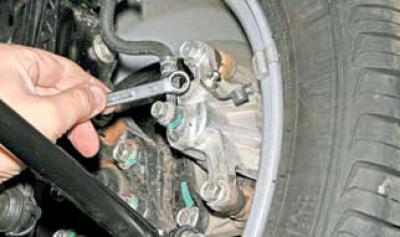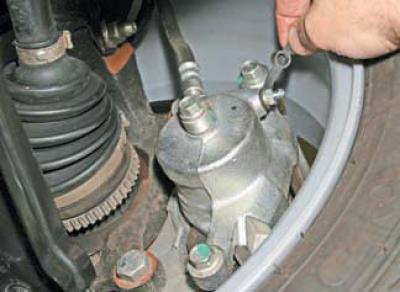We remove air from the system with the engine off, first from one circuit, and then from the other in the following sequence: - the brake mechanism of the right rear wheel; — the brake mechanism of the left forward wheel; — the brake mechanism of the left back wheel; — the brake mechanism of the right forward wheel.
If air gets into one of the circuits, it is enough to pump only this circuit, and not the entire hydraulic drive. Before pumping, we check the level of the working fluid in the reservoir of hydraulic brakes and clutches. Add liquid if necessary (see Checking the fluid level in the brake and clutch fluid reservoir).
We carry out bleeding of brakes with the assistant. We clean the bleeder valve of the brake mechanism of the right rear wheel from dirt..

... and remove the protective cap from it.

Using a 10 spanner, loosen the bleeder screw.
We put a hose on the fitting, and immerse its free end in a container partially filled with working fluid.
The assistant should vigorously depress the brake pedal to the stop 4-5 times and keep it pressed.

Using the "10" wrench, unscrew the bleeder valve by 1/2–3/4 turn.
In this case, fluid with air bubbles will flow out of the hose, and the brake pedal should be pressed all the way.
As soon as the liquid stops flowing out of the hose, we wrap the fitting and only after that the assistant can release the pedal.
Repeat pumping until no more air bubbles appear in the fluid coming out of the hose. We remove the hose, wipe the bleeder dry and put a protective cap on it.

Remove the protective cap from the bleeder valve of the brake mechanism of the left front wheel.

Using a 10 spanner, loosen the bleeder screw.
We put a hose on the fitting, and immerse its free end in a container partially filled with working fluid.
We pump, as described above..

... the brake mechanism of the left front wheel, unscrewing the bleeder valve with a "10" key.
Similarly, we pump the brake mechanisms of another circuit.
When pumping, you need to monitor the level of fluid in the tank and, if necessary, add fluid.
If when you press the brake pedal you feel its "softness" and increased travel, then there is air in the system. In this case, we repeat pumping until the pedal becomes "hard", i.e., when pressed, go no more than half the distance to the floor. If the air cannot be removed, we check the tightness of the connections, pipelines, hoses, main and working cylinders. We tighten the leaking connections, replace the faulty main and working cylinders (see Brake system).
